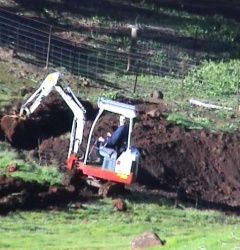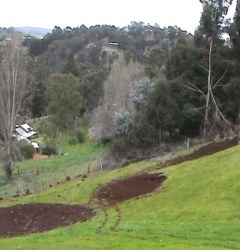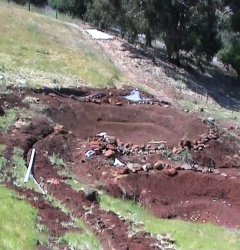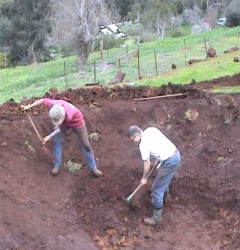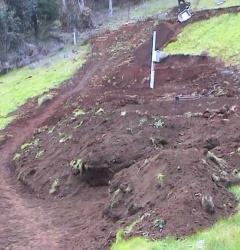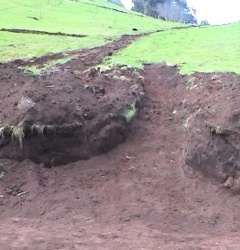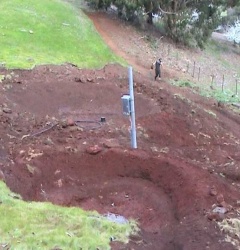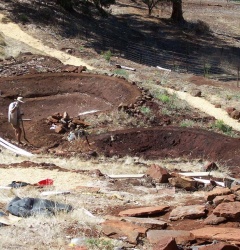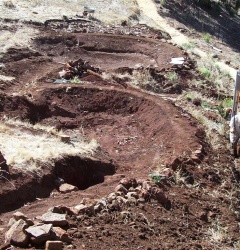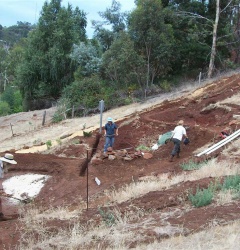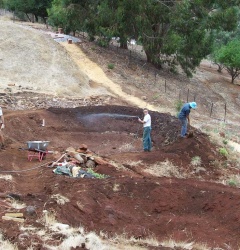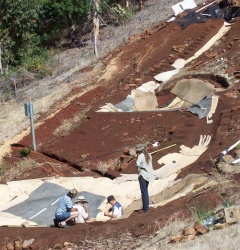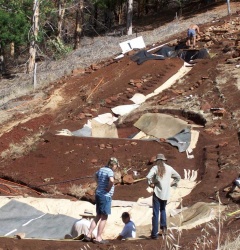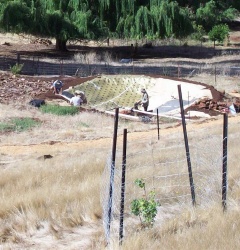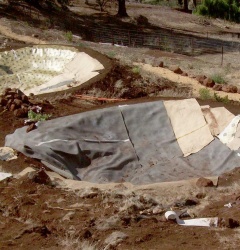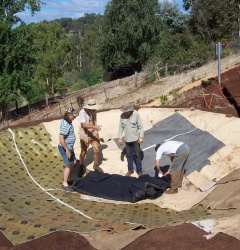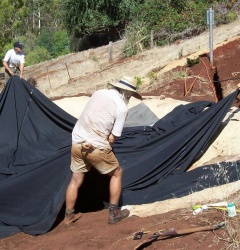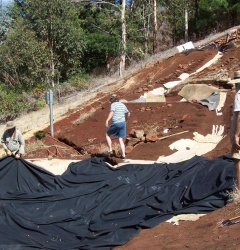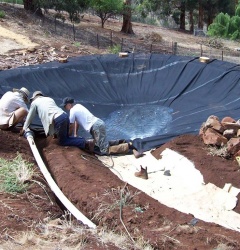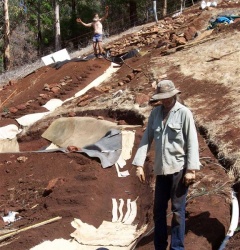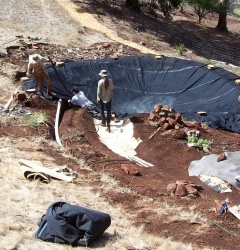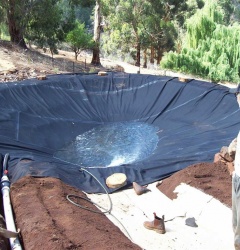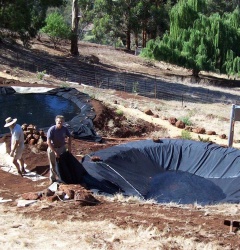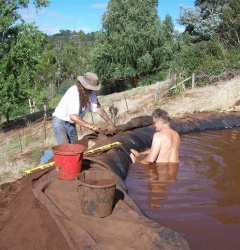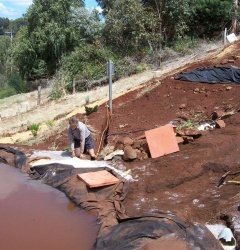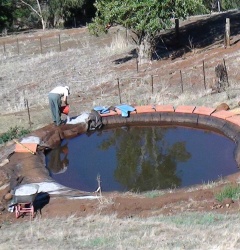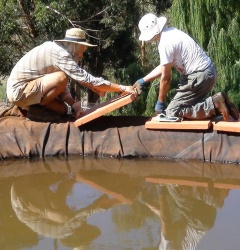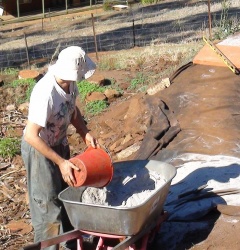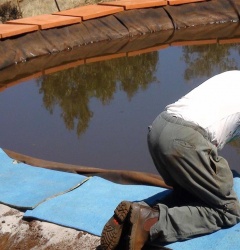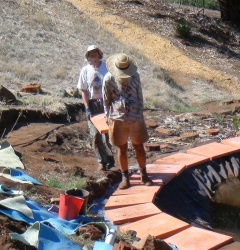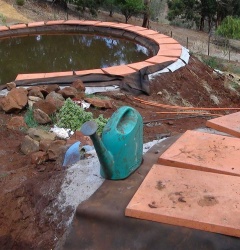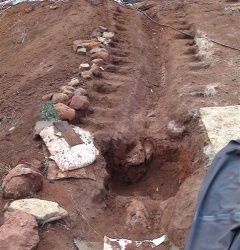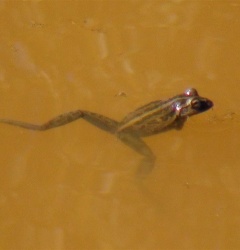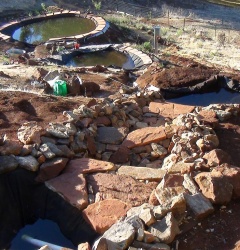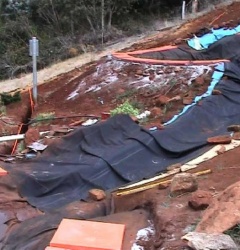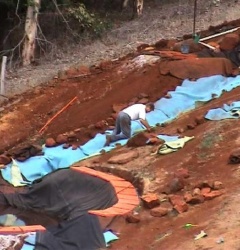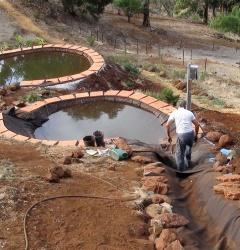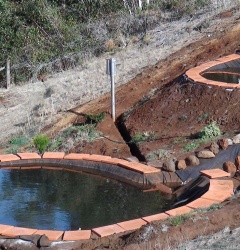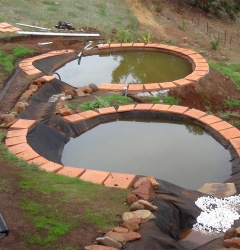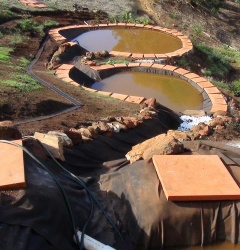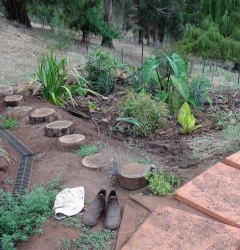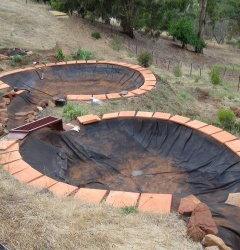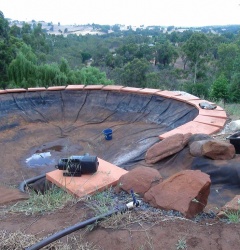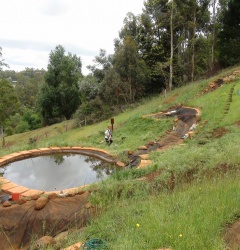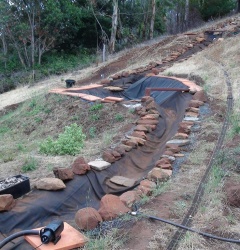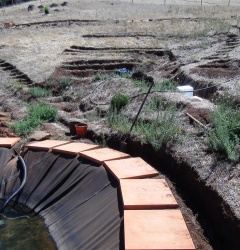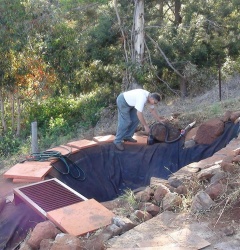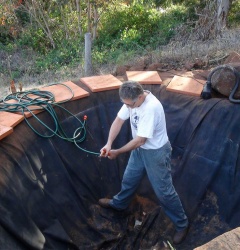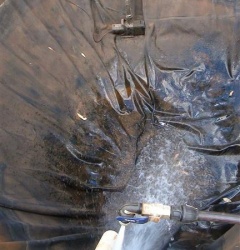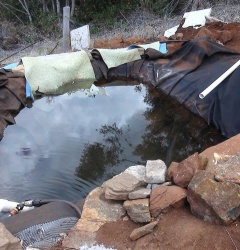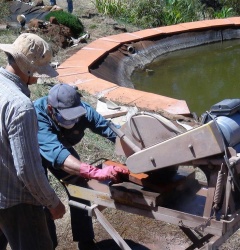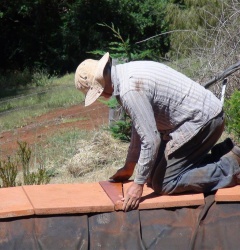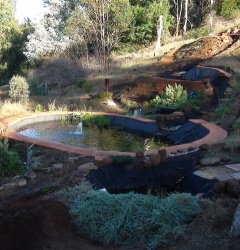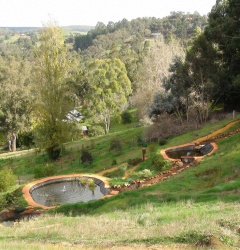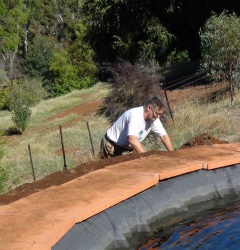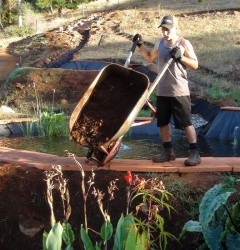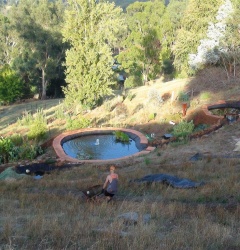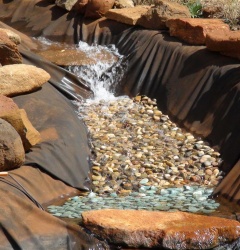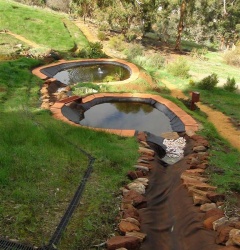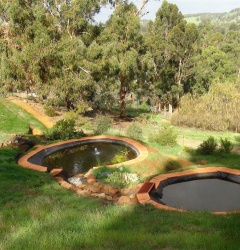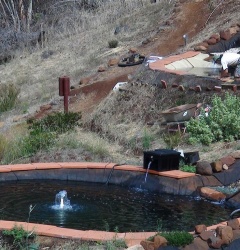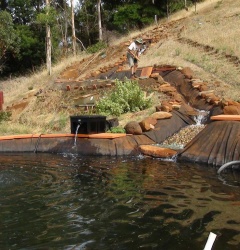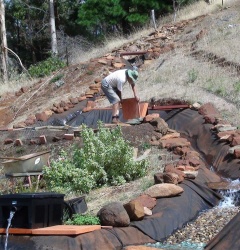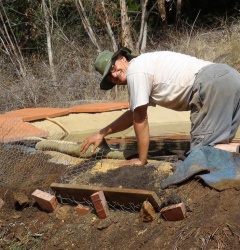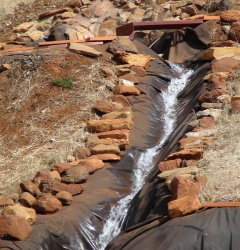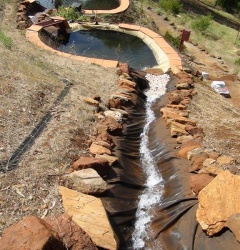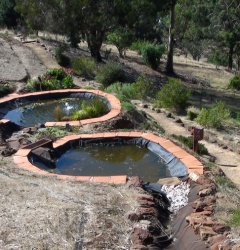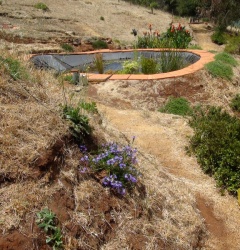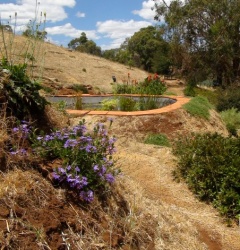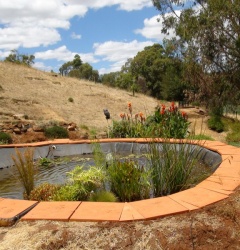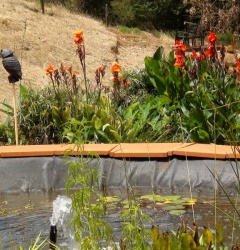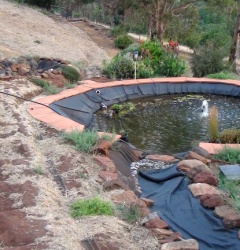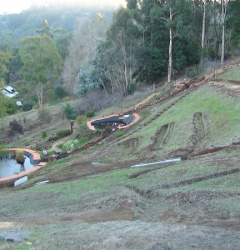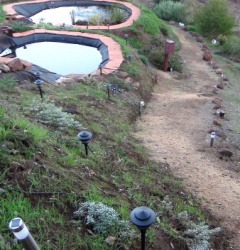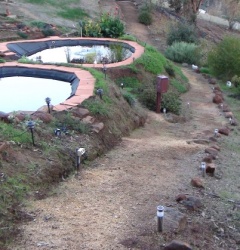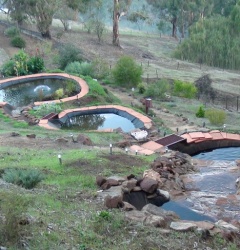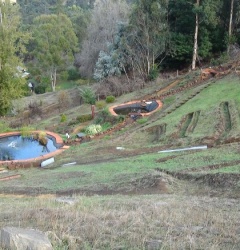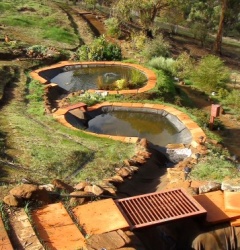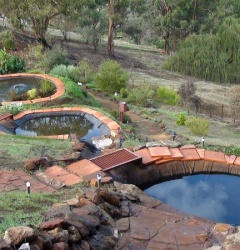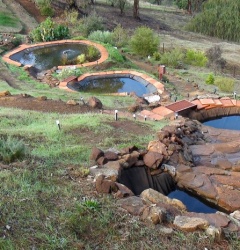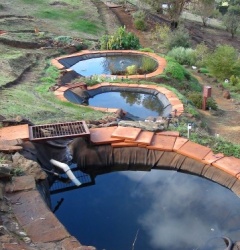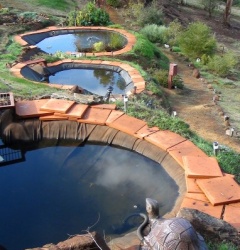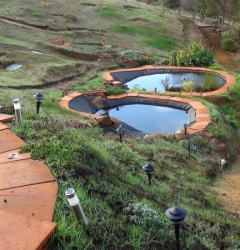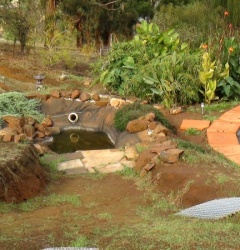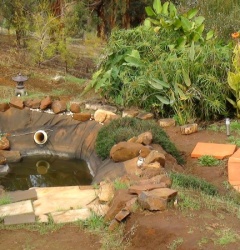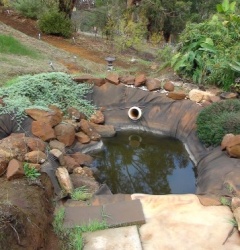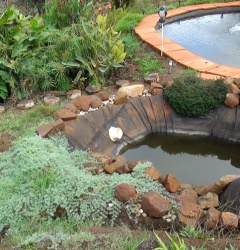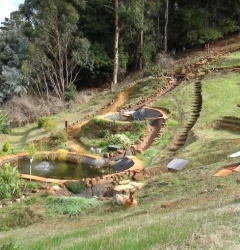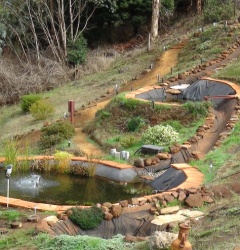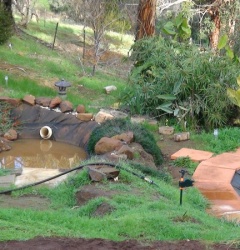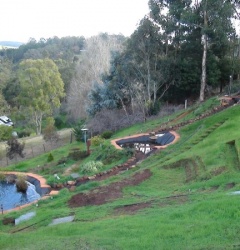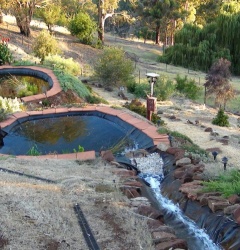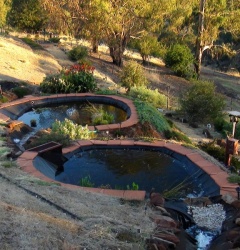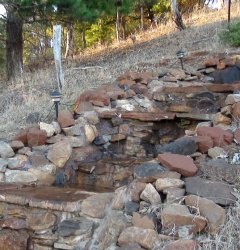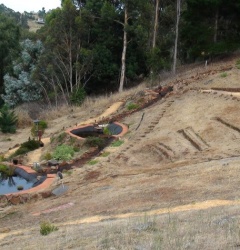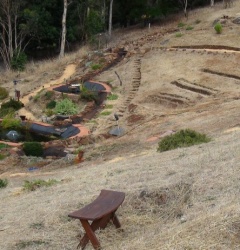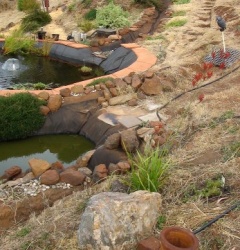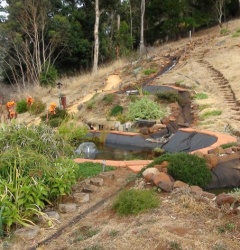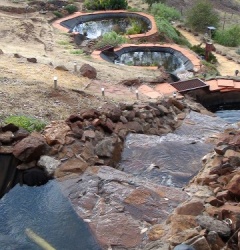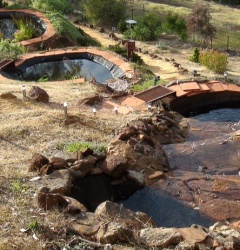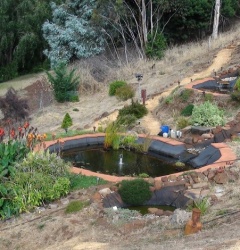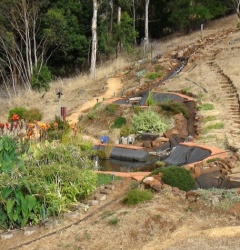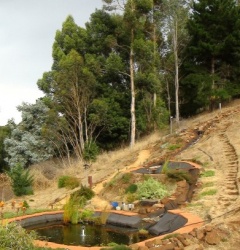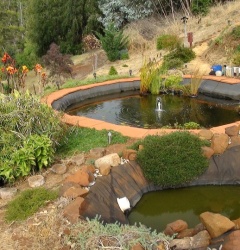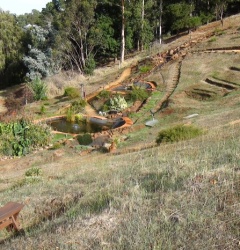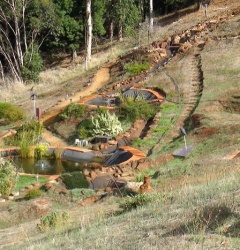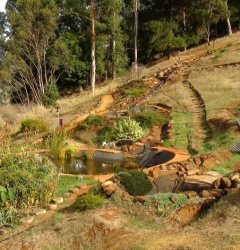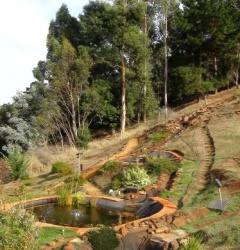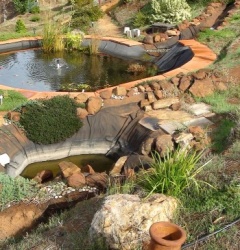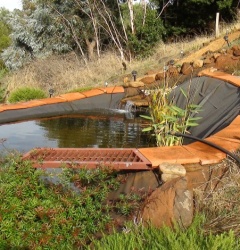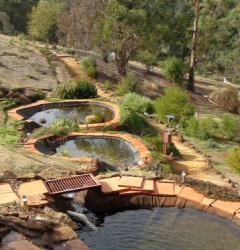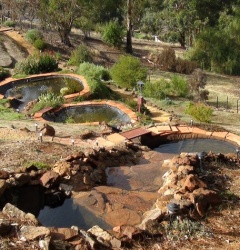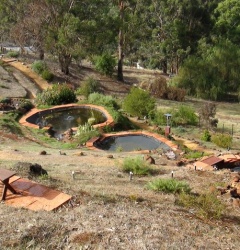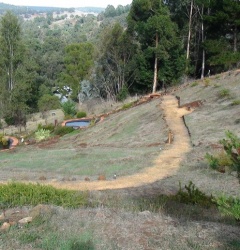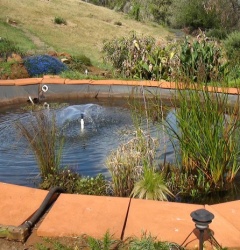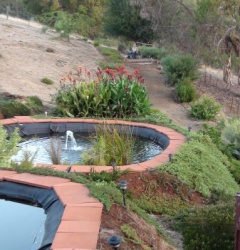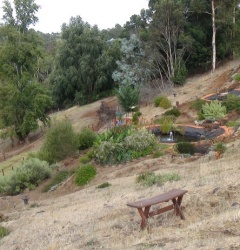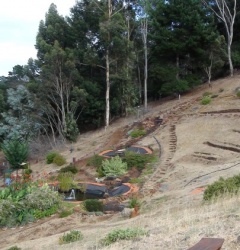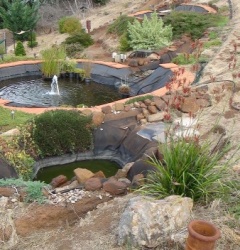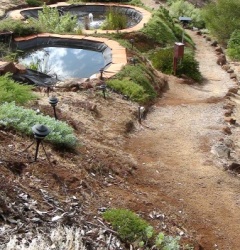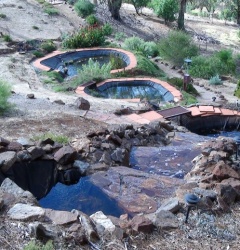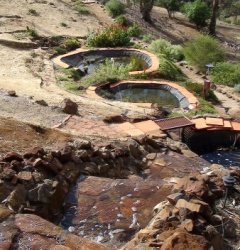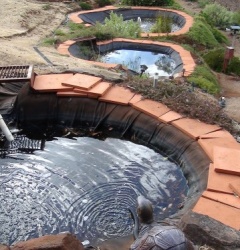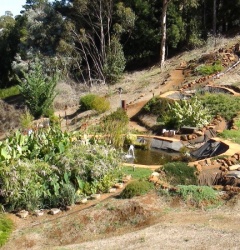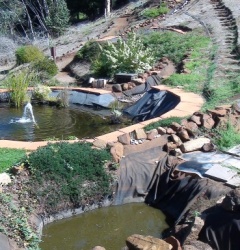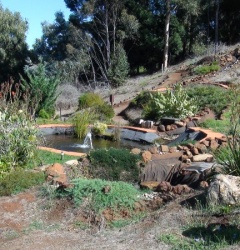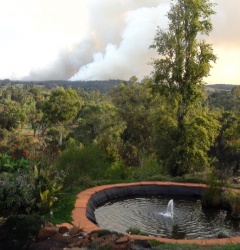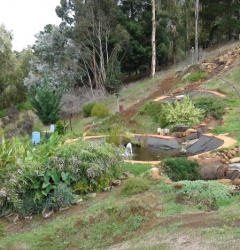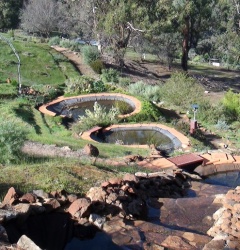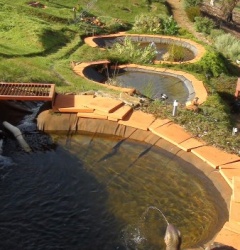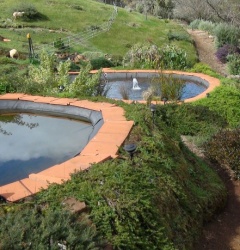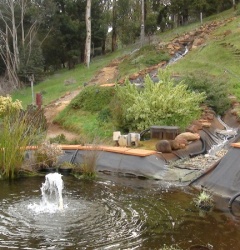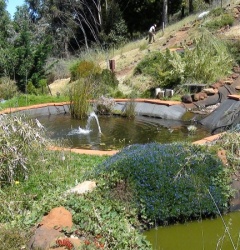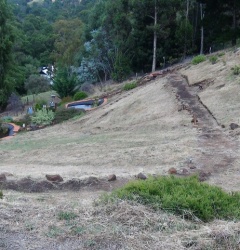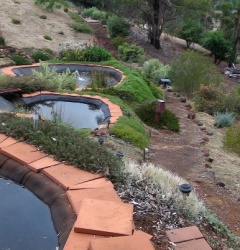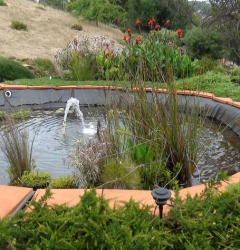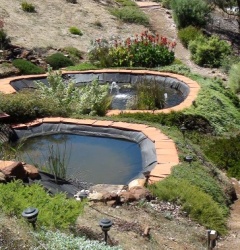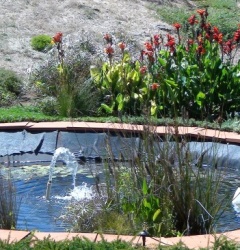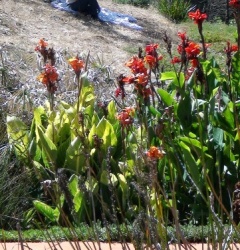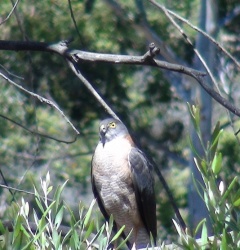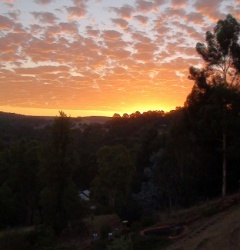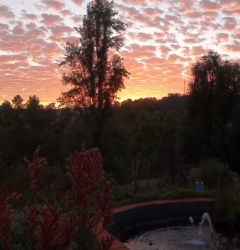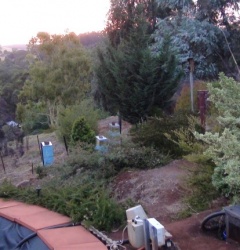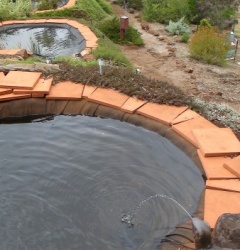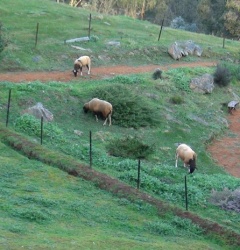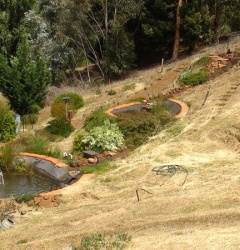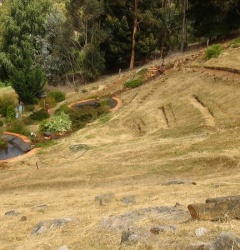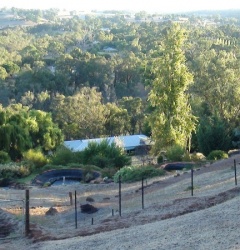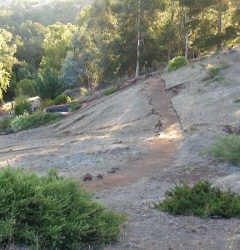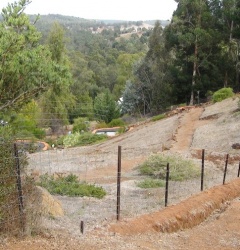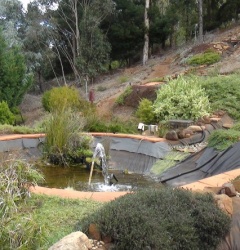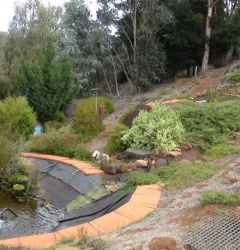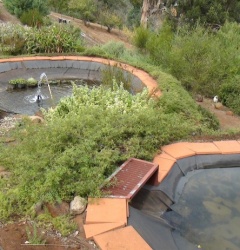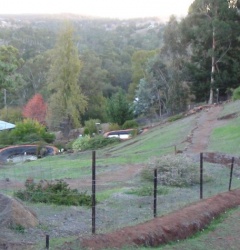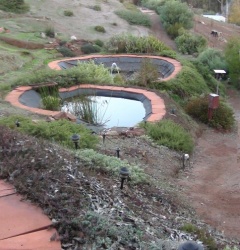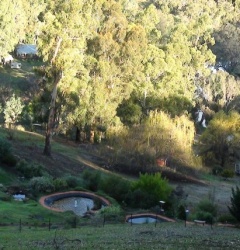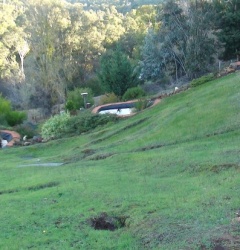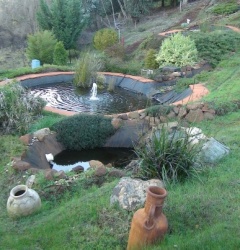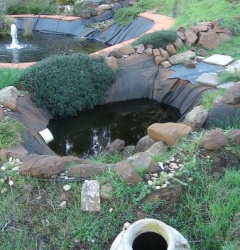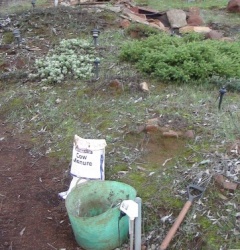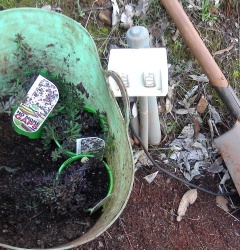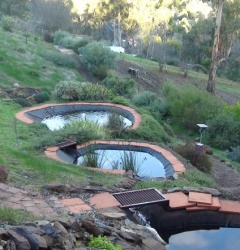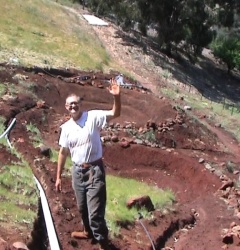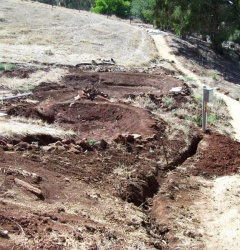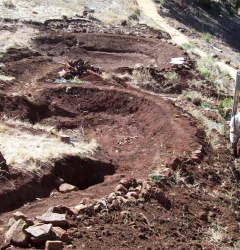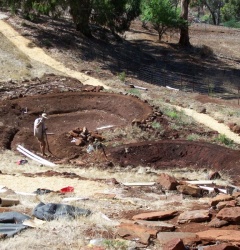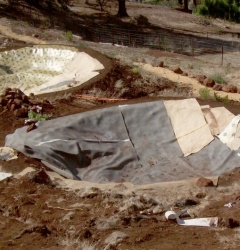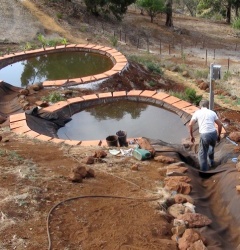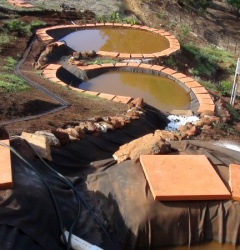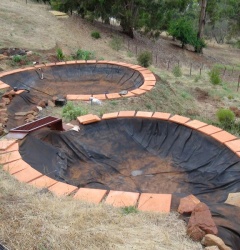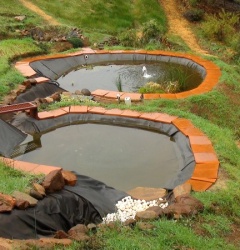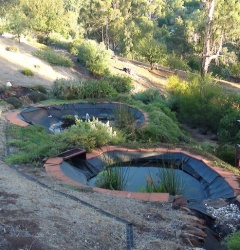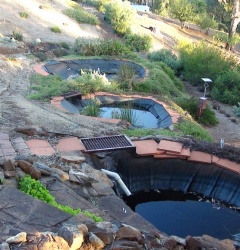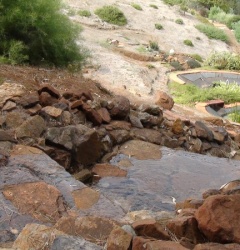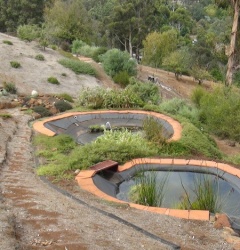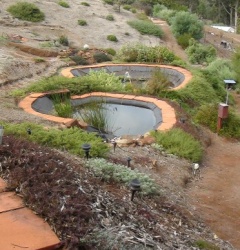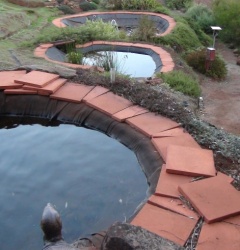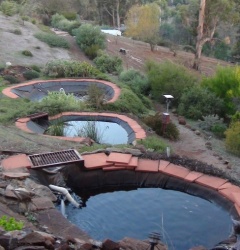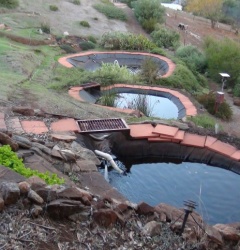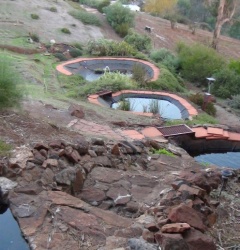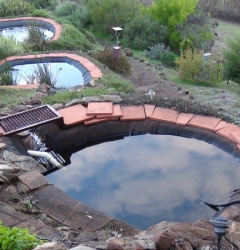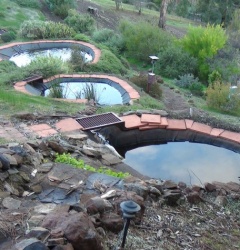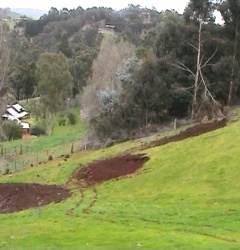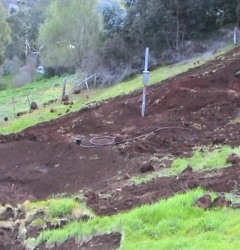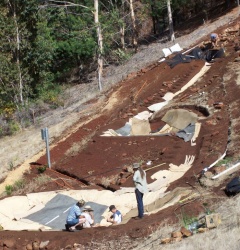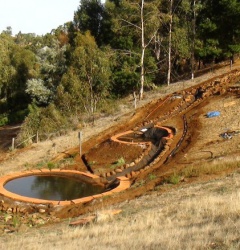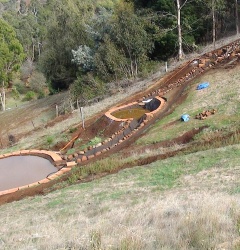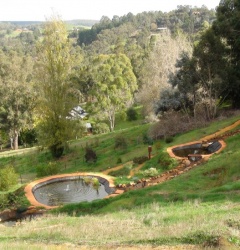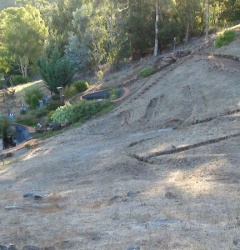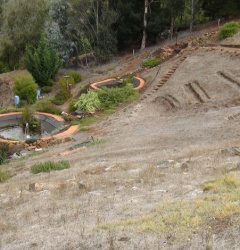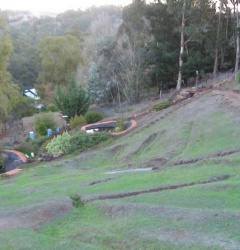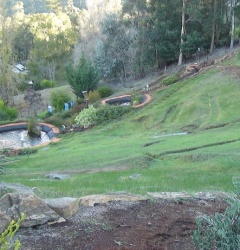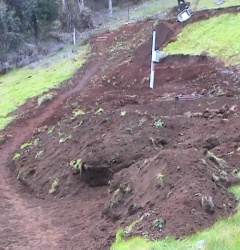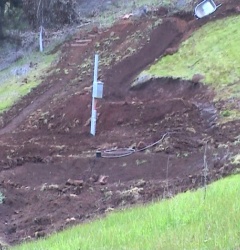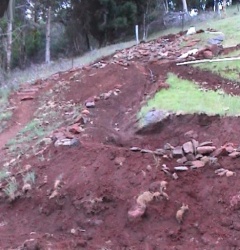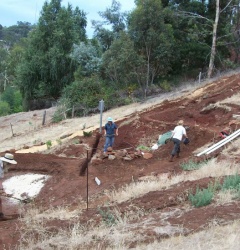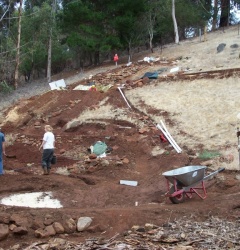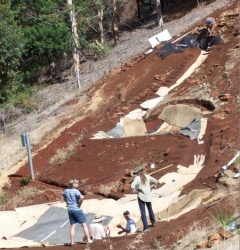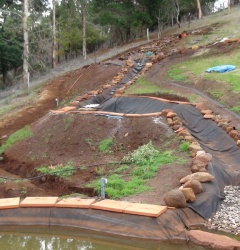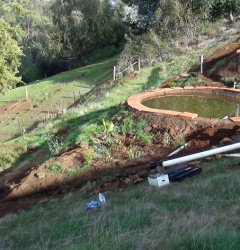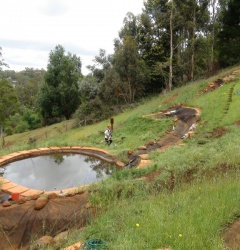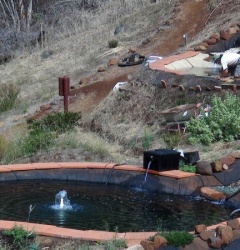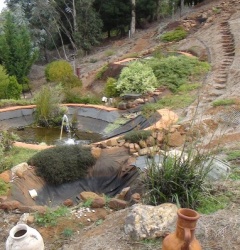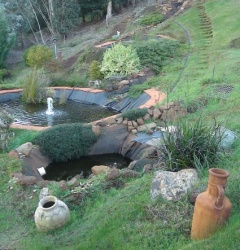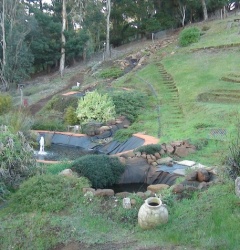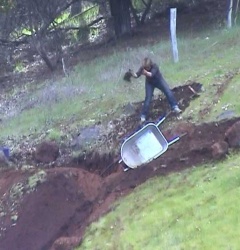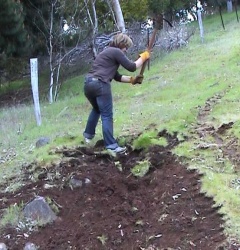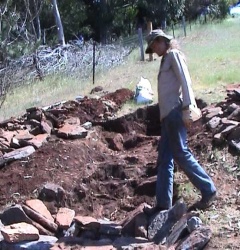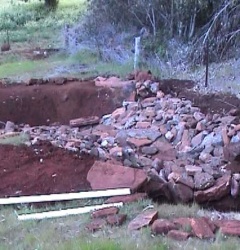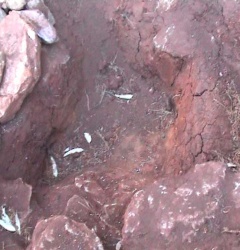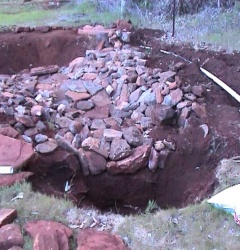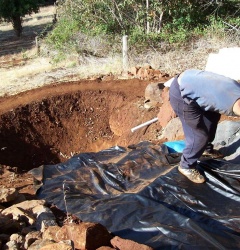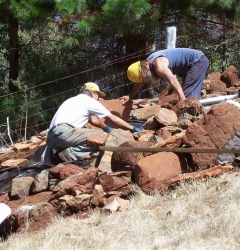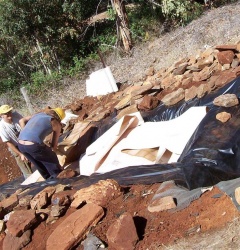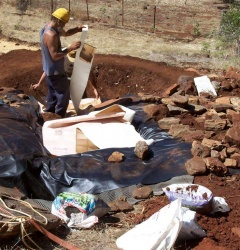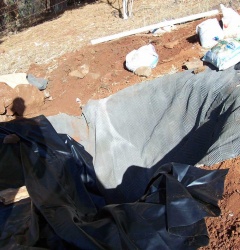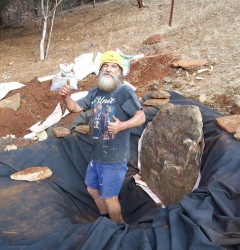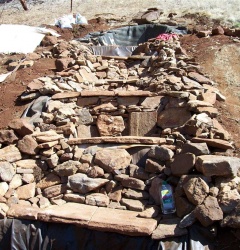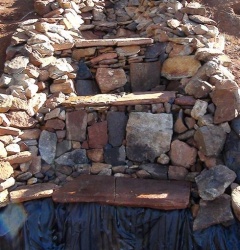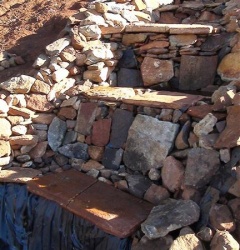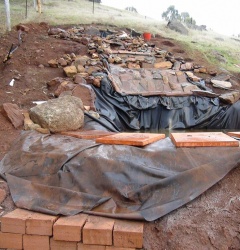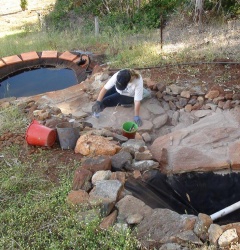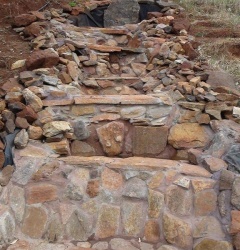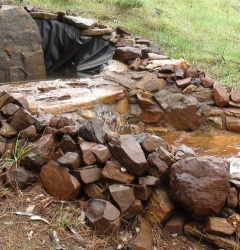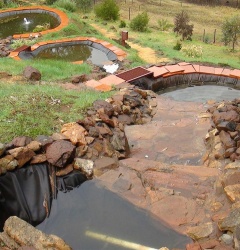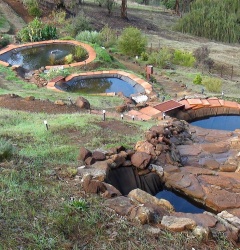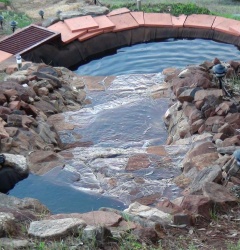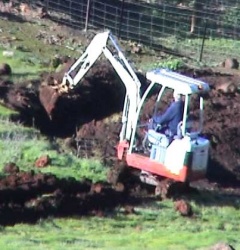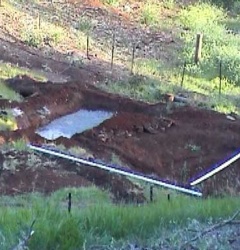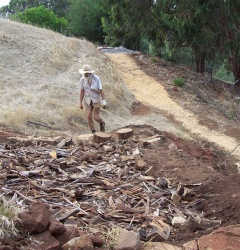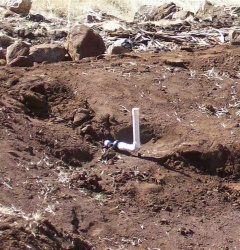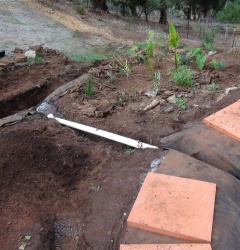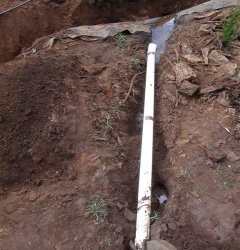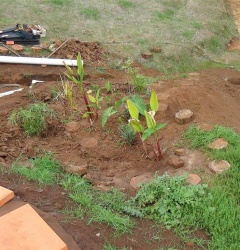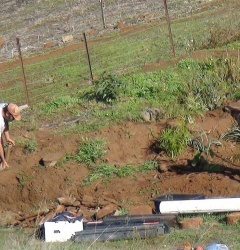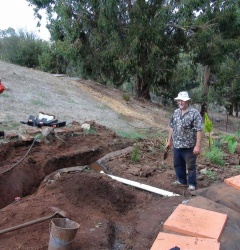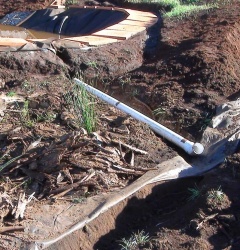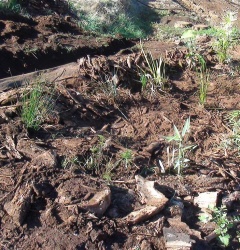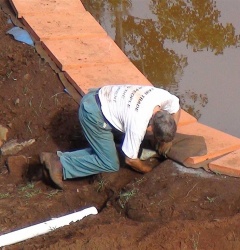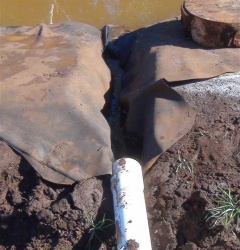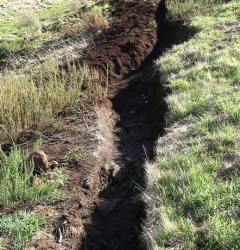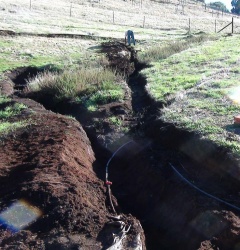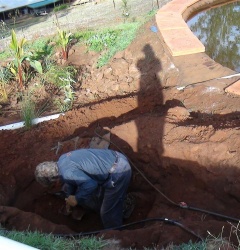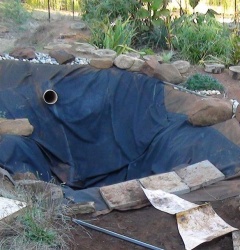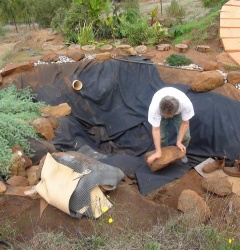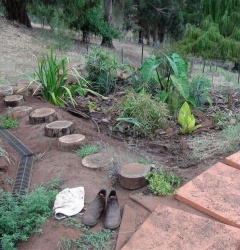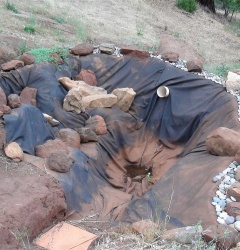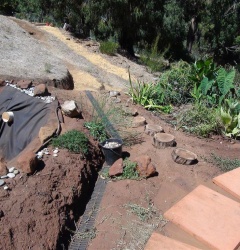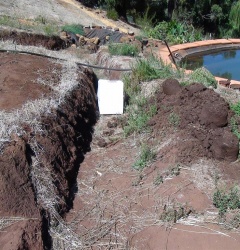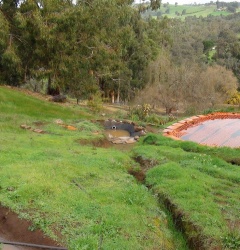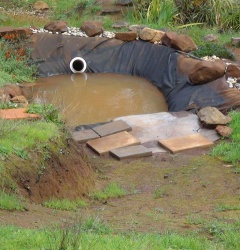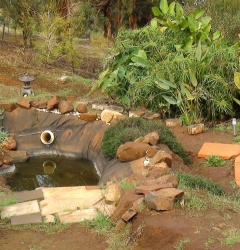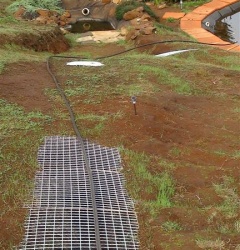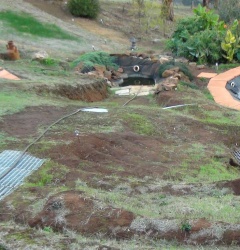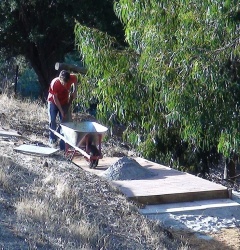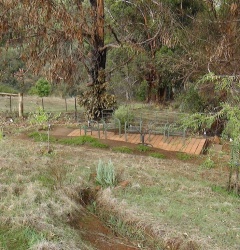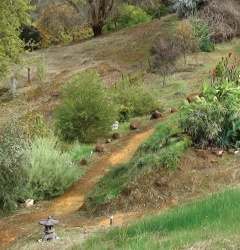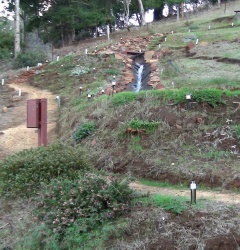Bottom Garden
Timeline showing the construction of the bottom garden and ponds between 2010 and the end of 2013









































































a smaller less steep part at the bottom end of the garden. This part of the garden contains the waterfall, streams,
ponds, pools, native trees, shrubs and groundcover plants. It supports three large ponds connected by two streams and
a waterfall. Independent to the pond-waterfall system is a bog pond and a rock pool. The bog pond is a small area of
wetland and the rock pool is a collection and discharge point for water flowing down the hillside when it rains heavily. In
September 2011 four large craters where dug out with a mini excavator and the earth used to reinforce the walls and
banks of four ponds and the two streams that connected the ponds. A trench was dug from the house to carry water and
electricity to the bottom of the garden and this cut through the middle of the bottom stream. The place looked like
a war zone. A couple of weeks later I set to work with pick and shovel fine tuning the shape of the ponds, compacted
soil around ponds, levelling the ledges and the bottom of the ponds, smoothing the pond walls and ledges and removing
any sharp stones from the ponds and streams so they would not puncture the pond liner when it was laid.
Timeline showing development of the bottom garden and ponds between 2014 and 2018












































































































 With the general shape of the pond system completed a thin layer of sand and then carpet underlay was laid across the top, middle and
With the general shape of the pond system completed a thin layer of sand and then carpet underlay was laid across the top, middle and
bottom ponds, which would provide a soft cushion for the expensive pond liner. The pond liner was thick and heavy.
Indeed the pond liner for the bottom pond was so heavy it took a small group of people to put it into position.
Timeline showing the ponds when viewed from above


































 The pond liner fitted perfectly over the ponds and the ponds were filled with water. The pressure
The pond liner fitted perfectly over the ponds and the ponds were filled with water. The pressure
generated by the weight of the water helped to hold the walls in place and for the next couple of weeks I got into
the ponds and made minor modification to the inner wall. More soil and rocks were added to the outer walls of the ponds,
which was compacted and allowed to settle and this was repeated several times until the walls were thick and strong.
A layer of sand was placed around edges of the ponds. The sand was smoothed level, covered with carpet underlay and
then covered by the edges of pond liner and finally about fifty concrete slabs were laid on top of everything.
Timeline showing the ponds when viewed from the gate



















 More trenches were dug. With better planning this could have been done quickly by the mini excavator
More trenches were dug. With better planning this could have been done quickly by the mini excavator
– but we did it by hand. One trench was for a pipe to take water from the bottom pond to top of pond, another was for
a pipe to take water from the top pond to the top of the waterfall and other trenches were for taking an underground
electric cable from central power box to locations around the ponds. When the ponds were done, a layer of sand and
then more carpet underlay was placed into the channels cut for the two streams. Pond liner was placed over the top
of the carpet underlay and the edges of the pond liner and carpet underlay fixed in place by large rocks. Finally a
thin layer of blue metal was used to hide the edges of the liner and underlay as it ran down the side of streams.
Timeline showing the ponds when viewed from below



















 A significant amount of tape was used to join the pieces of pond liner together, especially at
A significant amount of tape was used to join the pieces of pond liner together, especially at
the junctions between the ponds and streams. The tape was made of sticky tar like substance that stuck more readily
to the fingers of your hands than the pond liner. In the ponds I grew a range of water plants including aquatic garlic,
Vietnamese hot mint, reeds and range of colourful water lilies. These assisted in oxygenating the ponds and keeping
the water clean. In the bog pond I grew a range of marginal plants such as flowering rush, marsh marigold, elephant
ear (taro) and canna lilies.













































































































bottom ponds, which would provide a soft cushion for the expensive pond liner. The pond liner was thick and heavy.
Indeed the pond liner for the bottom pond was so heavy it took a small group of people to put it into position.
Timeline showing the ponds when viewed from above



































generated by the weight of the water helped to hold the walls in place and for the next couple of weeks I got into
the ponds and made minor modification to the inner wall. More soil and rocks were added to the outer walls of the ponds,
which was compacted and allowed to settle and this was repeated several times until the walls were thick and strong.
A layer of sand was placed around edges of the ponds. The sand was smoothed level, covered with carpet underlay and
then covered by the edges of pond liner and finally about fifty concrete slabs were laid on top of everything.
Timeline showing the ponds when viewed from the gate




















– but we did it by hand. One trench was for a pipe to take water from the bottom pond to top of pond, another was for
a pipe to take water from the top pond to the top of the waterfall and other trenches were for taking an underground
electric cable from central power box to locations around the ponds. When the ponds were done, a layer of sand and
then more carpet underlay was placed into the channels cut for the two streams. Pond liner was placed over the top
of the carpet underlay and the edges of the pond liner and carpet underlay fixed in place by large rocks. Finally a
thin layer of blue metal was used to hide the edges of the liner and underlay as it ran down the side of streams.
Timeline showing the ponds when viewed from below




















the junctions between the ponds and streams. The tape was made of sticky tar like substance that stuck more readily
to the fingers of your hands than the pond liner. In the ponds I grew a range of water plants including aquatic garlic,
Vietnamese hot mint, reeds and range of colourful water lilies. These assisted in oxygenating the ponds and keeping
the water clean. In the bog pond I grew a range of marginal plants such as flowering rush, marsh marigold, elephant
ear (taro) and canna lilies.




























it right. First a prototype was built that didn’t include any rock pools or features that would enhance the movement
of water. Then a waterfall was built that had the right design but didn’t have pond liner underneath the rock structure
and so it leaked. Then the waterfall was built with pond liner but the water ran between and under the rocks. Finally
the rocks of the waterfall were cemented in place and we had a functioning waterfall that was sealed.The process used
for the construction of the waterfall was similar to that used in the construction of the ponds. First the shape was
made by digging a series of steps in the ground going down the hill. Two small pools were created, one at the top of
the waterfall and one about half way down. The pools and steps needed to be dug a bit deeper to allow for the space
taken up by the carpet underlay, pond liner and rocks. An exaggerated waterfall shape was covered with carpet underlay,
then pond liner and finally rocks that were cemented in place over the top. A brown powder was added to the cement
to give it to a more natural earthy colour. To break up the overall colour around the rocks different amounts of the
dye were added to the cement in different parts of the waterfall.Many large rocks were hauled across the garden and
used in the building of the waterfall and ponds but by far the biggest was the one used as the head stone at the top
of the waterfall. This rock came from a massive pile of rocks located on my neighbour’s property and is named forever
the Pat Corrigan stone. Other features around the garden are similarly named after people directly or indirectly involved
with the creation of the garden – Feral Falls, Phil Pond, Spider Pond and Travis corner.



























on the hillside before ultimately being directed into a rock pool at the bottom of the garden. The water in the rock
pool is allowed to evaporate during dry periods so there is always plenty of room for it to fill up again during a
heavy rain. An overflow pipe releases water from the rock pool if it ever fills up to its maximum level and the pipe
takes it to a porous stone wall at the end of the property where it leaves in a controlled way.In addition to the system
dealing with the water coming down the hill there is an overflow system for the ponds. If the pond-waterfall system
is ever to fill up during heavy rain there are two overflow pipes built into the bottom pond. The first overflow pipe
is a large fixed pipe which joins the overflow pipe from the rock pool and takes overflow water out of the property
and down towards the Blackwood River. The second overflow pipe is adjustable and can be turned to take water from the
bottom pond and into the bog pond. The end of this pipe is open and the last few metres is perforated and dug into
the layer of blue metal under the bog pond. At the bottom of the bog pond is a layer of perforated pond liner sitting
on a layer of blue metal that lets water escape slowly, from the bog pond. Above the pond liner is another layer of
blue metal, then a layer of sand, a layer of top soil and a layer of tree bark as mulch.A continuous row of plastic
gutters was dug into the ground a couple of metres in front of the ponds and streams to function as another overflow
system for the rare but potentially damaging deluge of water coming down the hillside after a heavy downpour and as
barrier to prevent dirty water getting into the ponds.In addition to the row of gutters and the underground piping
system I created gaps either side of the large bottom pond for water to escape after heavy rain and for cold air to
escape in the morning. Winter mornings in the Blackwood valley can be cold and foggy and I reasoned that it would be
a good idea to help the fog escape as early in the morning as possible.
Bottom garden plants
Plants in bottom garden arm mostly native to Australia except where a native could not be found for a particular function
such as deciduous trees providing shade in summer but not winter.The area at the bottom of the hill is a natural sun
trap and water catchment area and a row of trees were planted at the bottom of the bottom garden to facilitate this.
One day these will be large and function as a sun trap to create a microclimate for an ecosystem of plants that thrive
in warmer conditions. The larger trees will also help hide the neighbour’s house from view. Shrubs and other small
plants are planted between the trees. Groundcover plants act as soil stabilisers helping to prevent soil erosion on
the banks of the hillside and ponds. Large rocks cover the hillside at the top of the western slope and down the eastern
slop of the bottom garden.For the bottom garden I preferred plants that grew locally in the South West of Western Australia
over Australian natives and I preferred natives to non natives – but I wasn’t going to be a purist. I mainly chose
plants for a function. There were soil stabilising plants, edible plants, colourful plants, nice smelling plants, plants
that provided nesting places for small birds and plants that produce flowers, seeds and fruits as food for wildlife.There
are three non native varieties of trees in the bottom garden, a conifer, Chinese elm and a snow pear. The Chinese elm
and a snow pear are deciduous and when mature should function to allow sun to the patio in winter and provide shade
in summer. They were selected because they are fast growing and attractive.Trees and large shrubs along bottom fence
functioning as a sun trap (in descending order of height from west to east): Cypress ocypasis (10 m x 4 m) non-native
planted as a fast growing tree for maximum height, Eucalyptus torquate (4 – 10 m x 3 – 5 m), Agonis flexuosa ‘After
Dark’ (6 m x 3 – 5 m), Calistemon – Bottle brush / Kings Park Special (4 m x 4 m) Syzygium australe ‘Bush Xmas’ (2
– 3 m x 1.5 m), Melaleuca nesophila (4 m x 4 m), Conostylis candicans (30 cm x 50 cm), Grevillea lemon supreme, Yellow
emu bush, Hakea Pincushion (5 m x 5 m), Hardenbergia (Purple spray) (1 m x 1 m), Grevillea Red Sunset. Jubilee Tea
tree and Eucalyptus erythrocorys (red capped gum) (4 – 5 m),Other trees and shrubs functioning as soil stabilisers
on hillside and for nectar feeding birds and frost and drought tolerant.: Billardiera heterophylla / Sollya heterophylla
(Bluebell creeper), Kangaroo Paws, Red Green and Joey Kangaroo Paws, Aussie Copper Lilly Pilly, Grevillea Crithmifolia,
Yellow Imp, Eremophila maculata (Spotted Emu Bush), Brachyscome (Rambo Cloud), Chorizema cordatum (Heart flame pea),
Grevillea Thelemanniana (Grey leaf Form), Leptospermum (Pink Cascade), Grevillea Thelemanniana, Boronia heterophylla
‘Ice Charlotte’, Coprosma, Solllya heterphylla, Kuneza Baxteri, Ugni Molinae (Chile Guava), Templetonia retusa (Cockies
Tongue), Red Bottle BrushGroundcovers functioning as soil stabilisers and for weed suppression on the hillside include
Myoporum parvifolium (Creeping Boobialla), Dampiera diversifolia, Scaevola aemula (Fandango Erect Early Blue), Scaevola
humilis (Purple Fusion), Hibbertia (Sunny Daze Yellow), Grevillea lanigera (Mt Tamboritha) Grevillea Gin Gin Gem, Blue
Lechenaultia (Lechenaultia biloba).

